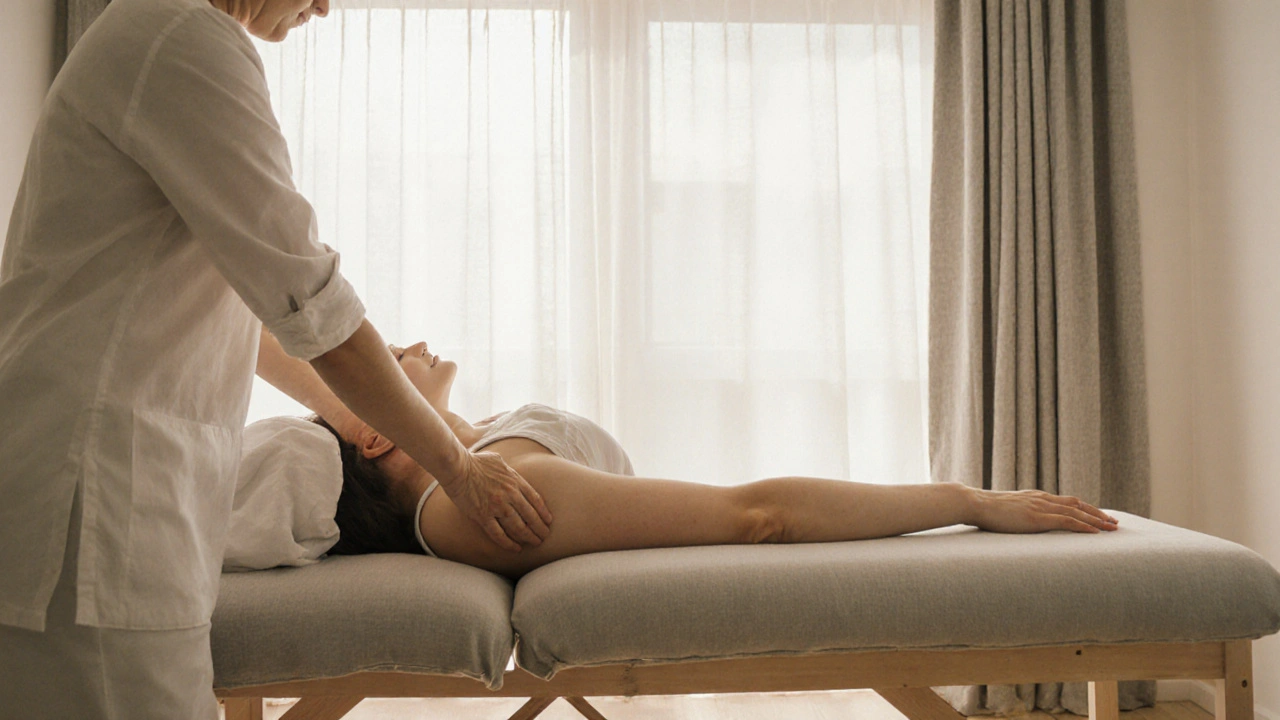The Healing Touch: How Trager Therapy Restores Movement and Calms the Mind

Trager Session Estimator
Imagine your body holding onto tension like an old sweater you never took off-tight around the shoulders, stiff in the hips, heavy in the legs. You stretch, you massage, you even try yoga, but the tightness comes back. What if the problem isn’t just your muscles, but your brain’s memory of how to move? That’s where Trager therapy comes in.
What Is Trager Therapy?
Trager therapy is a gentle, non-invasive form of bodywork developed by Dr. Milton Trager in the 1950s. Unlike deep tissue massage or chiropractic adjustments, it doesn’t force change. Instead, it invites the nervous system to let go of old patterns through effortless movement and touch.
The method combines two parts: mentastics-light, playful movements you do yourself-and table work, where a practitioner guides your body through slow, rhythmic motions. The goal isn’t to fix you, but to help you remember how it feels to move without effort.
Dr. Trager, a physician and physical therapist, noticed that when he moved his patients’ limbs with complete relaxation, their bodies responded differently. Not because he was stretching them, but because they felt safe. The brain, he realized, holds onto tension not because muscles are short, but because it’s afraid to release.
How It Works: The Science Behind the Touch
Trager therapy works on the nervous system, not just the muscles. When a practitioner moves your arm or leg with a soft, wave-like rhythm, they’re not trying to lengthen your tissue. They’re sending new sensory signals to your brain: "This movement is safe. You don’t have to hold on."
Studies in neuroplasticity show that repeated gentle input can rewire how the brain maps movement. A 2020 study in the Journal of Bodywork and Movement Therapies found that participants who received Trager sessions showed measurable improvements in range of motion and reduced muscle stiffness within just four sessions. The changes lasted weeks after treatment ended.
What makes Trager different is the quality of touch. Practitioners use what they call "hook-ups"-a state of deep presence where their own body is relaxed, grounded, and fully attentive. It’s not about technique. It’s about energy. When you’re moved by someone who’s completely calm, your nervous system starts to mirror that calm.
What Happens in a Session?
A typical Trager session lasts 60 to 90 minutes. You lie on a padded table, fully clothed, and the practitioner begins by gently rocking your limbs, spine, and head. There’s no pulling, no cracking, no pressure. It feels more like floating than being touched.
You might feel your arm rise slowly, as if it’s being lifted by water. Your legs might sway like pendulums. At first, you might wonder if anything’s happening. But then, something shifts. Your breath deepens. Your jaw unclenches. You realize you haven’t taken a full breath in days.
After the table work, you’re guided through mentastics-simple movements you can do anywhere. Think of them as playful exercises: rolling your head like a ball, letting your arms swing loose like wet towels, or bouncing gently on your feet like a child. These aren’t stretches. They’re invitations to rediscover ease.
One client, a 62-year-old nurse with chronic lower back pain, said after her third session: "I didn’t feel better because I was stretched. I felt better because I remembered how to move without trying."

Who Benefits Most?
Trager therapy isn’t a cure-all, but it’s especially powerful for people who’ve tried everything else and still feel stuck.
- People with chronic pain from stress, injury, or aging
- Those recovering from surgery or trauma who fear movement
- Athletes who feel tight despite stretching
- People with anxiety or PTSD who carry tension in their bodies
- Anyone who feels "heavy" or disconnected from their physical self
It’s not for people seeking quick fixes. If you want a massage that leaves you sore and relieved, Trager won’t deliver that. But if you want to feel lighter, freer, and more at home in your body-over time-it’s one of the most effective tools available.
Trager vs. Other Bodywork Therapies
How does Trager stack up against massage, Feldenkrais, or chiropractic care?
| Therapy | Primary Focus | Pressure Level | Client Participation | Long-Term Effect |
|---|---|---|---|---|
| Trager Therapy | Nervous system re-education | Very light, no pressure | Passive during table work; active in mentastics | Deep, lasting changes in movement awareness |
| Swedish Massage | Relaxation and circulation | Moderate to firm | Passive | Temporary relief |
| Feldenkrais | Movement awareness | None (self-guided) | Active | Improved coordination, slower results |
| Chiropractic | Joint alignment | High (adjustments) | Passive | Quick relief, risk of dependency |
Trager doesn’t try to fix what’s broken. It helps you forget how to be broken.
Can You Do It Yourself?
You don’t need a practitioner to start feeling the benefits. Mentastics are designed to be done daily, even for five minutes.
Try this simple exercise: Sit in a chair. Let your arms hang loose. Gently swing one arm back and forth like a pendulum-not with your muscles, but with the weight of your arm. Let gravity do the work. Do this for 30 seconds. Notice how your shoulder feels afterward.
Now try rolling your head slowly side to side, like a tired cat. No forcing. No holding. Just letting your neck move as if it’s made of jelly.
These aren’t stretches. They’re reminders. Your body already knows how to move freely. It just forgot.

What to Expect After a Session
Some people feel deeply relaxed. Others feel nothing at first. That’s normal. The changes often show up hours or days later.
Common experiences:
- Feeling lighter, as if you’ve lost a few pounds
- Improved posture without trying
- Deeper, easier breathing
- Reduced anxiety or mental chatter
- Better sleep
- Emotional release-sometimes tears, sometimes laughter
One man who’d been in pain for 12 years after a car accident said he didn’t feel better until three days after his session. "I woke up and realized I could turn my head without pain. I didn’t even know I’d been holding my neck tight all that time."
How to Find a Certified Practitioner
Trager International certifies practitioners worldwide. Look for someone with the title "Certified Trager Practitioner" (CTP). Training takes 300+ hours and includes anatomy, neurophysiology, and deep presence work.
Avoid practitioners who promise quick fixes, use force, or talk about "releasing toxins." Trager isn’t about detoxing. It’s about remembering.
Start with a single session. If you feel even a tiny shift in how your body moves or feels, it’s worth exploring further.
The Quiet Power of Trager
In a world that rewards effort-push harder, stretch more, do more yoga-Trager offers something radical: permission to stop.
It doesn’t ask you to change. It doesn’t demand discipline. It simply says: "Let me show you how it feels to move without fighting."
For people tired of battling their own bodies, that’s not just therapy. It’s a homecoming.
Is Trager therapy painful?
No, Trager therapy is not painful. It uses extremely light, rhythmic movements with no pressure or force. Many people describe it as feeling like floating or being gently rocked. If you feel discomfort, you should speak up-this method relies on comfort to create change.
How many sessions do I need to see results?
Some people feel a shift after one session, especially in relaxation and breathing. For lasting changes in movement patterns, most people benefit from 3-6 sessions spaced over a few weeks. Like learning a new skill, repetition helps the brain remember the new way of moving.
Can Trager therapy help with anxiety?
Yes. Because Trager works directly on the nervous system, many people report reduced anxiety, quieter thoughts, and better emotional regulation after sessions. The gentle, non-invasive touch signals safety to the brain, which can lower cortisol levels and activate the parasympathetic nervous system-the body’s rest-and-digest mode.
Is Trager therapy covered by insurance?
Most insurance plans do not cover Trager therapy, as it’s classified as an alternative therapy. However, some health savings accounts (HSAs) or flexible spending accounts (FSAs) may allow reimbursement if you have a letter from a healthcare provider. Always check with your provider.
Can I do Trager therapy if I have a medical condition?
Trager is generally safe for most people, including those with arthritis, fibromyalgia, or post-surgical recovery. However, if you have severe osteoporosis, recent fractures, or acute inflammation, it’s best to consult your doctor first. A certified practitioner will adapt the session to your needs.





